Effect of methyl paraben, propyl paraben and formalin preserved milk on chemical composition during storage
Suvartan Ranvir*, Saurabh Gosewade, Harish Kumar and Raman Seth
Dairy Chemistry Division, National Dairy Research Institute, Karnal, Haryana, India. Corresponding Author Email: suvartanranvir@gmail.com
DOI : http://dx.doi.org/10.13005/ojc/310436
Article Received on :
Article Accepted on :
Article Published : 07 Dec 2015
This study was carried out to check the preserving effectiveness of methyl paraben and propyl paraben in comparison with formalin in milk for analytical purpose. The pooled raw cow milk were collected from the institute cattle yard and the milk samples were preserved with methyl paraben at conc. 0.1 % , propyl paraben 0.1 % and formalin 0.4% and it was analysed for Fat, Acidity, Total Solid, Lactose and Protein. The result of this analysis shows that milk is preserved with 0.1% methyl paraben and 0.1 % propyl paraben observed no significant effect on fat, total solids and protein contents but lactose content was significantly decreases during storage and it is also found that percentage acidity increases after nine day of storage. Sample preserved with methyl paraben and propyl paraben found that slightly higher total solid content as compared to control and formalin preserved milk samples. The milk sample preserved with 0.4 % formalin observed that there is no effect on total solids and protein content, but it shows that an immediate increase percentage acidity on first day, however during storage it remains constant and found decrease level of fat content. The finding of this experiment is concluded that, methyl and propyl paraben have poor preserving ability as compared to formalin for long term storage period but for short storage it act as a good alternative preservative of formalin for analytical purpose.
KEYWORDS:Methyl Paraben; Propyl Paraben; Formalin; Milk; Preservatives
Download this article as:| Copy the following to cite this article: Ranvir S, Gosewade S, Kumar H, Seth R. Effect of methyl paraben, propyl paraben and formalin preserved milk on chemical composition during storage. Orient J Chem 2015;31(4). |
| Copy the following to cite this URL: Ranvir S, Gosewade S, Kumar H, Seth R. Effect of methyl paraben, propyl paraben and formalin preserved milk on chemical composition during storage. Orient J Chem 2015;31(4). Available from: http://www.orientjchem.org/?p=13084 |
Introduction
India has become the leading milk producer in the world producing near about 140 million tonnes according to the latest estimate (NDDB 2014). In India cost of milk is determined on the basis of fat and SNF content. So that adulteration of milk increasing day by day for increasing Fat and SNF content. Addition of urea, starch, flour, skimmed milk powder, whey powder or other ingredients used for increased lactometer reading (Abdul et al. 2014).
To control such type of malpractices and ensure food safety and security, governments appoint food safety officers who carry out the chemical examinations of milk and milk products. But the main problem during analysis of milk samples lifted by food safety officer which may take some days for analysis due to which it may lead to spoilage of milk samples because quite high initial bacterial counts due to insanitary conditions during milk production and high nutrient content make it the perfect breeding ground for bacteria, So as to avoid such type of problem in milk it need to be preserve. The preservation of milk can be achieved by chemical, microbiological and physical methods. Recently scientist are using various chemical milk preservatives e.g Formalin, Hydrogen Peroxide, Potassium Dichromate, Sodium Azide, Mercuric Chloride and Bronopal (Upadhyay et al. 2014). Formalin is the legally permitted preservative for preserving milk meant for analytical purposes. However, its addition interferes with the estimation of various constituents of milk. Many of the researchers have reported that formalin affects various physico-chemical properties such as fat, protein, lactose and total solids content of milk during storage. Dawood et al. 1974 reported that addition of 0.1% formalin to milk increased the titratable acidity from 0.175%to 0.190%. Des Raj and Singhal 1987 observed that Gerber method gave consistently low fat value in milk sample preserved with formalin. Boghra 2003 also observed same results that formaldehyde interferes during fat estimation in milk. Narayanan, 1973 found no change in total solids content of milk containing formalin at the rate of 0.1 ml per 25 ml milk stored at room and refrigerated temperature. Nelson et al. 1956 reported that formalin used in the proportion of one part of formaldehyde to 1500 parts of milk gave slightly higher lactometer reading. Bajaj and Rai, 1993 observed that formaldehyde adversely affects the protein content by Lowery’s method. Sandhu et al. 1984 reported that no change in lactose by Lane-Eynon method in formalin preserved samples during storage up to one year.
Methyl and Propyl Parabens used as chemical preservatives in foods such as coffee extracts, fruit juices, soft drinks, baked goods, seasonings, sugar substitutes and frozen dairy products at concentrations of between 450 and 2000 ppm (Seetaramaiah K 2011). There is no study has been carried out to check the preservative effect of methyl paraben (MP) and propyl paraben (PP) in milk and their effect on milk constituents during analytical testing.
Acknowledgement
The first author acknowledges the financial assistance provided by ICAR-NDRI (Deemed University), Karnal. Consistent guidance given by the advisory committee members Dr. Raman Seth, Dr. Darshan Lal, Dr.S.K.Kanawjia, Dr. Surajit Mandal and Dr. Rajan Sharma is also gratefully acknowledged.
Materials and Methods
Milk Samples
Authentic pooled samples of raw cow milk were collected from the institute cattle yard and milk samples were preserved with methyl paraben, propyl paraben and formalin at concentration 0.1, 0.1 and 0.4% respectively. These preserved milk samples were analysed every three days interval for Fat, Acidity, Total Solid, Lactose and Protein. The preserved milk samples were stored in 250 ml air tight glass bottles and kept at refrigeration temperature (7°C) separately.
Estimation of fat in milk sample
Estimation of fat in milk sample was carried out by Gerber method as per BIS (IS: 1224 – part-1, 1977).
Determination of Titratable acidity of milk
Titratable acidity of milk samples was determined as per the procedure described in BIS (IS: 1479 (part-1) 1960
Determination of total solids
Determination of total solids in milk preserved with methyl paraben and formalin was carried out as per the procedure given by Bureau of Indian Standards BIS (IS: 12333- 1997).
Determination of Lactose in Milk
Titratable acidity of milk samples was determined as per the procedure [SP: 18(XI)-1981]
Determination of Protein in Milk by Kjeldahl Method
Protein content of preserved milk sample was determined as per the procedure given by AOAC 17th edn. 2000 official method 991.23.
Result and Discussion
Effect of methyl paraben, propyl paraben and formalin preserved milk sample on chemical composition during refrigeration storage.
Fat: Fat estimation which was done at every three days interval Gerber method and results are presented in Graph No. 1. Fat percentage in the control milk sample during storage upto 3 days was 5.2 – 5.1 %, but after third day storage the sample was found curdled hence further study was not carried out. In preserve milk sample with 0.1 % methyl paraben, 0.1% propyl paraben, 0.4% formalin varied between 5.2 -5.1, 5.2-5.0 and 4.7-5.1%, respectively upto the twenty one days storage. The fat percentage in 0.4% formalin treated milk was significantly decreases (P < 0.05) than the 0.1% PP treated and 0.1% MP treated milk. Formalin preserved milk sample when analysed for fat content by Gerber method, found to be decrease during storage. The fat percentage decreases in formalin preserved milk because formalin cause hardening effect on the milk protein owing to the formation of high molecular weight polymer between formalin and milk proteins (Conrat and Olcott, 1946). Such type of effect not observed in milk preserved with methyl and propyl paraben milk samples. Bajaj and Rai (1992) also reported lower estimation of fat in formalin preserved milk samples during storage.
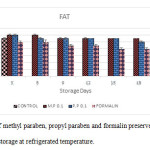 |
Figure 1: Graph 1: Effect of methyl paraben, propyl paraben and formalin preserved milk sample on fat percentage during storage at refrigerated temperature. Click here to View figure |
Acidity
Acidity percentage estimated by titration method and that results are presented in Graph No. 2. Acidity percentage in the controlled milk sample was 0.131–0.170 % upto 3 days storage but after third day storage the sample was found curdled hence further study was not carried out. In preserve milk sample with 0.1 % methyl paraben, 0.1% propyl paraben, 0.4% formalin acidity percentage varied between 0.132-0.179, 0.133-0.188 and 0.139-0.165%, respectively upto the twenty one days storage. The acidity percentage was observed significantly increases (P < 0.05) during storage in the control, 0.1% PP treated, 0.1% MP treated and formalin preserved milk sample. Formalin treated milk was observed that after addition of formalin acidity percentage immediately increases but in case of control, 0.1% PP treated, 0.1% MP treated milk samples, observed acidity percentage remains constant. But during storage it is found that in MP treated and PP treated milk samples acidity percentage increases rapidly as compared to formalin preserved milk sample after the nine day storage. In formalin preserved milk sample titratable acidity percentage immediate increases, because of liberation of carboxylic groups from protein which is not due to conversion of lactose to lactic acid by bacteria. Sandhu et.al, 1984 also reported that the addition of 0.4 and 0.6 % formalin caused an immediate increase in titratable acidity. In control, methyl paraben and propyl paraben preserved milk samples acidity increases, which might be due to development of acidity by lactic acid bacteria
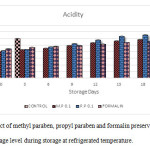 |
Figure 2: Effect of methyl paraben, propyl paraben and formalin preserved milk sample on acidity percentage level during storage at refrigerated temperature. Click here to View figure |
Total Solid
TS content of all the preserved milk samples was estimated by gravimetric method and results are presented in Graph No 3. The total solids in control milk was found to be 13.76-13.72 % upto 3 days storage. In preserve milk sample with 0.1 % methyl paraben, 0.1% propyl paraben, 0.4% total solids percentage was varied between 13.79 – 13.75, 13.80-13.75 and 13.77-13.73 respectively upto the twenty one days storage. In all preserved milk sample observed that non significant (P < 0.05) change in total solids percentage during storage. In MP and PP added milk samples observed that slightly higher TS content as compared to control and formalin preserved milk samples, which changes may be due to some components of MP and PP have slightly low solubility due to its some components interferes the TS content. Formalin preserved milk did not showed such type of effects, our findings are in accordance with those found by repeated Bector and Narayanan, 1973 and Bajaj and Rai, 1992 who stated that the TS content by gravimetric method not affected in formalin preserved milk.
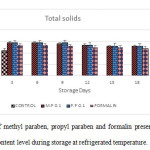 |
Figure 3: Effect of methyl paraben, propyl paraben and formalin preserved milk sample on total solid content level during storage at refrigerated temperature. Click here to View figure |
Lactose
The lactose content in methyl paraben, propyl paraben and formalin preserved milk sample was determined by Lane eynone method and results are presented in Graph No.4. The lactose content of control milk sample was 4.69–4.76 % upto 3 days storage. In preserve milk sample with 0.1 % methyl paraben, 0.1% propyl paraben, 0.4% formalin lactose percentage varied between 4.74-4.57 %, 4.74-4.56 and 4.71-4.77 % respectively upto the twenty one days storage. The lactose percentage in control, 0.1% PP treated and 0.1% MP treated milk was significantly decrease (P < 0.05) than in the 0.4% formalin treated milk samples. In methyl paraben and propyl paraben shows slightly decreases lactose content during storage, which is might be due to fact that during storage of milk lactose is utilized by bacteria and gets converted into lactic acid, such type of effect not observed in milk preserved with formalin. Our results are agree with the finding of Sandhu. et al 1984 and Bansal 1989 who reported that there was no change in lactose percentage in milk preserved with formalin.
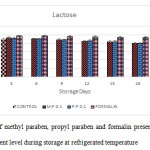 |
Figure 4: Effect of methyl paraben, propyl paraben and formalin preserved milk sample on lactose content level during storage at refrigerated temperature Click here to View figure |
Protein
Protein estimation in control and preserved milk sample was estimated by Kjeldahl method and results are presented in Graph No. 5. Protein content in control milk sample was found to be 3.48-3.45 %. up to 3 days storage. In preserve milk sample with 0.1 % methyl paraben, 0.1% propyl paraben, 0.4% formalin protein percentage varied between 3.46-3.41 %, 3.47-3.42 and 3.46-3.42 % respectively upto the twenty days storage. The protein percentage was observed non-significantly (P < 0.05) changes during storage in the control, 0.1% PP treated, 0.1% MP treated, 0.4 formalin preserved milk sample. Our results are in accordance with the finding of Bector and Narayanan 1973 and Bansal 1989 who reported no change protein content in milk on addition of formalin.
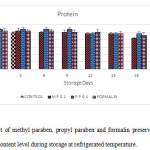 |
Figure 5: Effect of methyl paraben, propyl paraben and formalin preserved milk sample on protein content level during storage at refrigerated temperature. Click here to View figure |
Summary and Conclusion
This study was carried out to check the effect of methyl paraben, propyl paraben and formalin preserve milk samples on the major constituents of milk such as fat, acidity, total solids, lactose and protein which was storage up to the twenty one days at refrigeration temperature. Milk preserved with methyl paraben and propyl paraben at concentration 0.1% each shows that no effect on fat, total solids and protein contents but lactose content was significantly decreases during storage. In case of milk preserved with 0.4 % formalin shows that no effect on total solids and protein contents but it shows immediate increase in acidity, however during storage it remains constant and also shows that decrease fat content in preserved milk samples.
From above finding we are concluded that, methyl paraben and propyl paraben have poor preserving ability as compared to formalin for long term storage period but for short storage period methyl paraben and propyl paraben act as a good alternative preservative for analytical purpose.
References
- Abdul A.S. Muhammad K. Muhammad A.M. Ghulam S.B. Study on adulteration and composition of milk sold at Badin. Int. J. of Res. in App. Nat. and Soc. Sci. 2014, 9, 2347-4580.
- Annual Reports/nddb-annual-report, 2013-2014.pdf.
- AOAC. Official method of analysis of the association of official analytical chemists, 11th edn Washington, DC, (1970).
- Bajaj V.K. and Rai T. Comparative efficiency of various analytical methods for fat and total solid determined gravimetrically in formalin preserved milk samples. Ind. J. of Ani. Sci. 1992, 62, 1096-1098.
- Bansal A. Effect of formalin on different constituents of cow and buffalo milks with particular reference to fat globule membrane (FGM). Ph.D. Thesis. Kurukshetra University, Kurukshetra, Haryana, (1989).
- Bector B.S. and Narayanan K.M. Studies on the changes in the composition of milk containing formalin during storage. J. of Food Ind. 1973, 5, 5-6.
- Boghra V.R. and Borkhatriya V.N. Physico-chemical properties and compositional profile of milk samples as affected by formalin preservation – A review. Ind. J. of Dairy Sci. 2003, 56, 65-71.
- Conrat F.H. and Olcott H.S. Reaction of formaldehyde with protein 2 participation of the Guadinyl and evidence of crosslinking, J. of Ame. Chem. Soci. 1946, 68, 34-37
- Dawood A.E. Nagghmous M.R. and Nofel A.A. Effect of certain additives on acidity and formal number of milk. J. of Agric .Res. 1974 22: 73-76
- Des Raj and Singhal O.P. Effect of formalin on the Gerber fat test. J .of Food Sci. and Tech. 1986, 24: 183-184.
- Daniel J.W. Metabolic aspects of antioxidants and preservatives, Xenobiotica, 1986, 16: 1073–1078
- IS: 1224. (Reaffirmed 1997). Indian Standards method of determination of fat: Apparatus for determination of milk fat by Gerber method part-1, Bureau of Indian Standards, New Delhi, (1977).
- IS: 1479:1960. Method of test for dairy industry part-1 rapid examination of milk, Bureau of Indian Standards, New Delhi, (1960).
- IS: 12333. Indian Standards: Milk Cream and Evaporated milk determination of total solid content. Reference method (First Revision), Bureau of Indian Standards, New Delhi, (1977).
- Mabrook M.F. and Petty M.C. A novel technique for the detection of added water to full fat single frequency admittance measurements. Sensors Actuator. B Chem. 2003, 96, 215–218.
- Nelson M.L. Deutsch M.N. and Clifton C.M. (1958). Milk preservatives for solid not fat determination. J. of Dairy Sci. 1958, 41: 727
- Sandhu J.S. Nasir N. Narayanaswamy M. and Kapur O.P. Study on the effect of formalin as a preservative on different constituents of raw milk samples during storage. J. Food Sci. Tech. 1984, 21, 424-425.
- Shrivastava M.K. Handbook of analysis of Milk, (2010).
- Seetaramaiah K. Smith A. Murali R. and Manavalan R. Preservatives in Food Products – Review. Int J. Pharma & Bio Archives 2011, 2: 583-599.
- Upadhyay N. Goyal A. Kumar A. Lal D. and Singh R. Preservation of milk and milk products for analytical purposes. Food Reviews Int. 2014, 3, 203-224

This work is licensed under a Creative Commons Attribution 4.0 International License.









